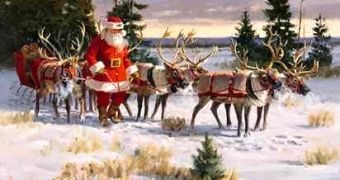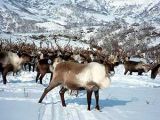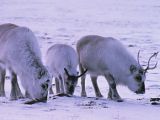Waiting for Rudolph to bring you Santa Claus with the presents? Well, here is some data about this amazing Ice Age deer.
1.Reindeer are believed to have appeared during the last glaciation, 15,000 years ago. Their roots seem to be in South America. 5 million years ago, South America and North America got united through the Panama Isthmus. Then, fauna interchange took place: deer, jaguars and monkeys entered South America, while opossums, armadillos and porcupines entered North America.
These deer evolved specifically in South America, and 2 million years ago, a fossil forest deer, probably Agalmoceros (from Ecuador and Boliva) or Morenelaphus brachyceros (of Patagonia), passed through the Andes into the mountains of Central America and from there into the Rocky Mountains.
During the last glaciation, in North America, there appeared the first reindeer, Rangifer fricki which passed through Behring land bridge into Asia (the opposite route made by man, bison, brown bear, wapiti deer and gray wolf). In Asia, this primitive reindeer evolved into the modern reindeer, Rangifer tarandus.
During the glaciation, the reindeer got to very low latitudes in Europe. The Magdalenian culture of western Europe (20,000 to 12,000 years ago) it is also called "the age of reindeer", due to reindeer cave paintings found in the caves of Lascaux (France) and Spain (Altamira).
2.Reindeer live in groups, small during the winter (4-30 individuals) and large during the summer. The herds are led by a male or a female with the largest antlers.
Reindeer consume grass, but during the fall they pass to mushrooms, willows and other food sources, and during the winter, their base diet is made of likens and moss. During the winter, a reindeer can ingest 4-7 kg (9-15 pounds) of likens daily; during the summer they eat a double quantity of food. Reindeer also eat bark, twigs and even ... lemmings (small rodents)! During the winter, reindeer can be fed with fish remains (in fact, cattle in northern Norway are known to eat boiled fish heads and in some barren islands ruminants were seen to eat meat). The likens ferment inside the reindeer stomach, releasing heat.
The main food competitors for reindeer are lemmings, polar hares and musk ox (only in Greenland and northeastern Canada).
Reindeer can be up to 1.5 m (5 ft) tall at the shoulder and weigh 315 kg (670 pounds).
3.Reindeer are the only deer species in which the female bears antlers. In some Canadian populations, females are devoid of antlers. The span of the antlers can be over 1.5 m (5 ft) on an adult male. After the breeding season, male reindeer lose their antlers, which start regrowing in March.
The antlers represent a calcium reserve for the females. Calcium passes from the antlers into the female's blood, serving for the development of the fetus's bones, if the food is poor in calcium. Female reindeer lose their antlers when the calf is born. Female's antlers are smaller and simpler compared to those of the males.
The velvet (skin) of the antlers is removed by the reindeer during their growth by rubbing the antlers against trees. The reindeer antler velvet contains pantocrine, a heart stimulator (in Russia, reindeer are farmed for getting this drug). Fallen antlers are chewed by lemmings for calcium and other minerals.
The well irrigated antlers help eliminate heat during the summer, and it is supposed that this is why females have antlers too.
4.Reindeer males form harems of 5-40 females during the breeding season, in September-October. They fight for this right like any other deer. Gestation takes 8 months and female give birth to 1 (rarely 2) calves.
Female reindeer give birth in groups at the end of the winter, in areas over the tree limit. There temperature rarely overcomes -15 oC and wolves do not reach this area. The births are synchronous so that the females do not get late into the reindeer migration. 23 % of the newborn die during the first month, because of avalanches, predators, malnutrition or exhaustion during migration. By 1.5 years, young reindeer are sexually mature.
Reindeer milk is very fat: up to 24 % fat at the beginning, and 10 % after that (cow milk has about 3 % fat). The offspring has to accumulate fast an insulator fat layer under the skin.
5.Reindeer do not eliminate urea through urine; it is used for protein synthesis in case of a diet poor in proteins. The urea also leads to the accumulation of water in the outer fatty tissues, working like a thermal insulator.
There are also other adaptations to cold: thick furs made of thin, soft under-hair and thick cover hair; nostrils covered by 1 cm long hairs, and during the winter, the sole covered by hair.
6.Tundra reindeer migrate during the summer. Migrating reindeer herds are made of 10,000 to 100,000 individuals. The migration is 1,000-1,600 km (820-1,000 mi) long. Woodland caribou and Peary caribou do not migrate; the woodland caribou just reach the edge of the forest.
The start of the migration is triggered by snow, temperature, predators and blood-sucking insects. The migration speed is 7 km (4 mi) per hour, 150 km (110 mi) per day. Reindeer swim with 10 km (6 mi) per hour. A moving herd of reindeer (caribou) emits a characteristic sound pop, produced by the slide of tendons over toes' bones.
7.Reindeer (as it is called in Eurasia) or caribou (as it is called in North America) has several geographical races:
-Woodland Caribou (R. tarandus caribou), or forest caribou, once found in the North American taiga (boreal forest) from Alaska to Newfoundland and Labrador and as far south as New England and Washington. Woodland Caribou have disappeared from most of their original southern range and are considered "threatened" where they remain, with the notable exception of the Migratory Woodland Caribou of northern Quebec and Labrador, Canada. The name of the Cariboo district of central British Columbia relates to their once-large numbers there, but they have almost vanished from that area in the last century. A herd is protected in the Caribou Mountains, in Alberta. Births take place in May-beginning of June. It feeds rather on bushes than grasses. It lives in groups of 10-15 individuals. The skin was used by Amerindians for making tents and clothes.
-Porcupine caribou or Grant's Caribou (R. tarandus granti) in Alaska, the Yukon and the Northwest Territories of Canada, has a population of about 330,000 individuals. It is smaller than woodland caribou. It lives in the tundra in the summer and forests in the winter. They can mix in the winter with woodland caribou, but they split in the summer. They form groups of thousands of individuals and feed mainly on mosses and likens, but also grass and bushes. Eskimos hunt these caribous.
-Finnish forest reindeer (R. tarandus fennicus) is encountered in two areas: Finnish/Russian Karelia, and central south Finland.
-Tundra caribou (R. tarandus groenlandicus) from Nunavut, Northwest Territories of Canada and in western Greenland has a population of about 700,000.
-Peary caribou (R. tarandus pearyi), from northern islands of the Nunavut and the Canadian Northwest Territories, has a population of about 3,000; this is a dwarf race (up to 100 kg or 220 pounds).
-Svalbard Reindeer (R. tarandus platyrhynchus), found on the Svalbard islands, is a dwarf race and the smallest reindeer (60-80 kg or 130-170 pounds and just 80 cm (2.6 ft) tall).
-Eurasian reindeer (R. tarandus tarandus), found in the Eurasian tundra. Domesticated reindeer all belong to this race (including those introduced in North America). There are still about 852,000 wild reindeer.
Two reindeer/caribou races are extinct:
-Arctic reindeer (R. tarandus eogroenlandicus) disappeared in 1900 in eastern Greenland.
-Queen Charlotte Islands caribou (R. tarandus dawsoni) from the islands with the same name, British Columbia, Canada.
8.Reindeer live up to 15 years. Wolves hunt about 11-14 reindeer per individual annually. Reindeer can reach a top speed of 55 km (35 mi) per hour. A fly has parasite larvae, long to 2.5 cm (1 in) in reindeer; to avoid this pest, reindeer form small groups or take refuge in the forests.
Today, there are 2,400,000 domestic reindeer in Russia, 532,500 in Scandinavia and 41,200 in North America. In China, 1,000 reindeer were introduced, and 2,000 reindeer exist in the subantarctic island of Kerguelen. The domestic reindeer introduced in Alaska represents a danger for the local caribous, as they compete for food and can cross, the hybrids being more resistant.
The building of a dam on a river, which was found on the way of the caribou migration, led years ago to the mass drowning of thousands of animals. Migrations are perturbed in Alaska also by the oil conducts and intense human activity.

 14 DAY TRIAL //
14 DAY TRIAL // 

